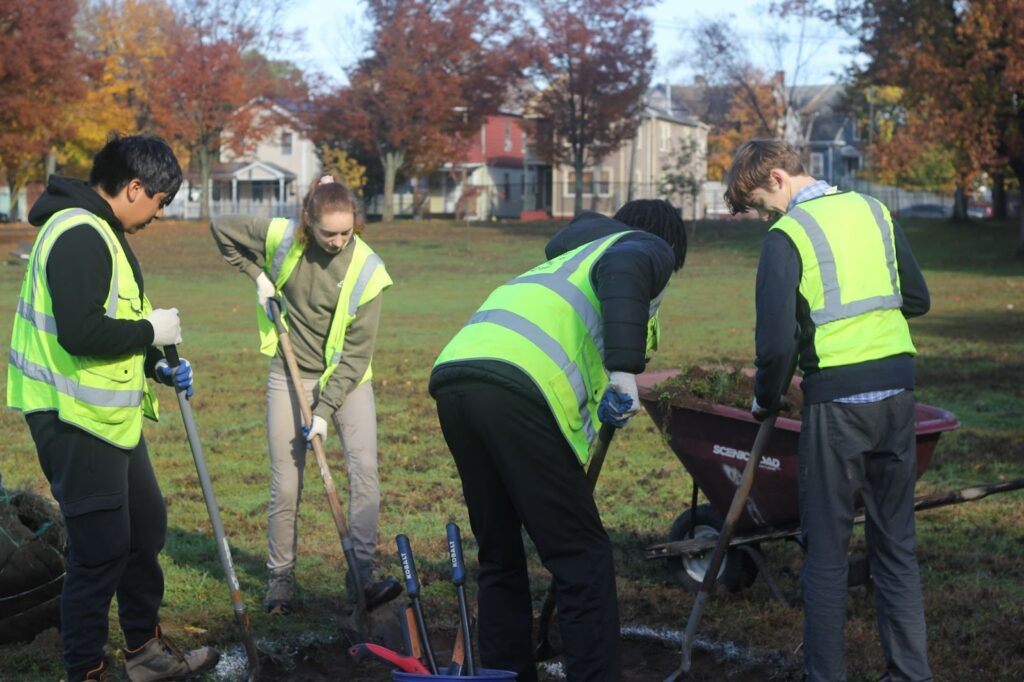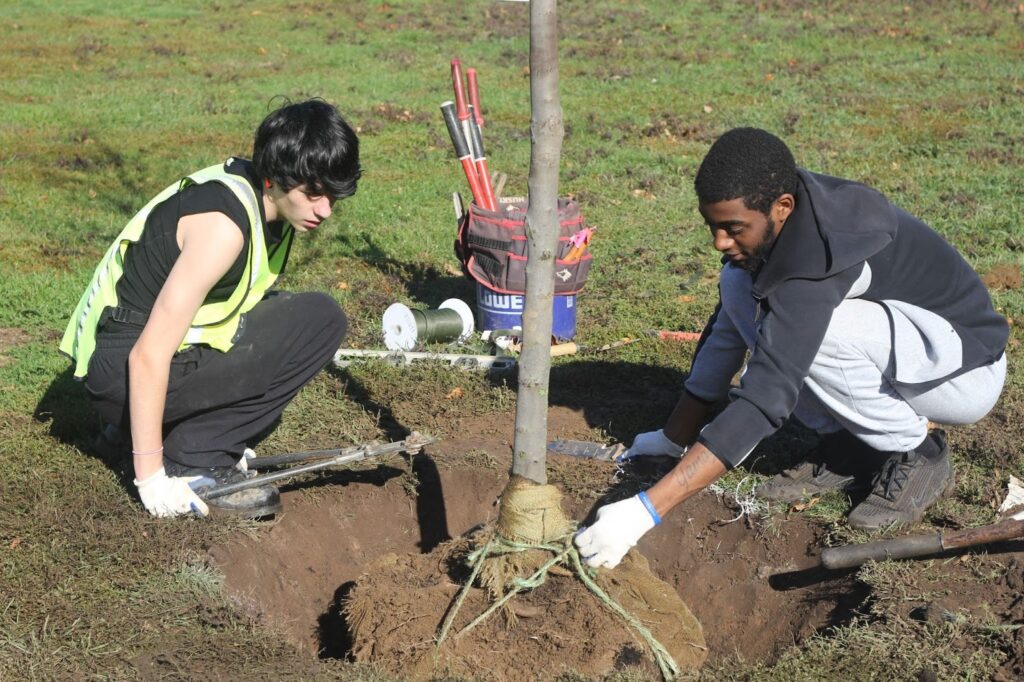Yale initiative striving to regreen New Haven, with 13,000 trees so far
The Urban Resources Initiative, started in 1989, involves Yale and New Haven students and other community members in planting trees around the city.
Michelle So 3:16 am, Nov 12, 2025
Staff Reporter

Michelle So, Contributing Photographer
At 8 a.m. on a Saturday morning, volunteers from the Urban Resources Initiative loaded three open-bed pickup trucks with shovels, tarps, axes and buckets.
The initiative began in 1989 as the idea of School of the Environment professor [William Burch](https://environment.yale.edu/news/artic…
Yale initiative striving to regreen New Haven, with 13,000 trees so far
The Urban Resources Initiative, started in 1989, involves Yale and New Haven students and other community members in planting trees around the city.
Michelle So 3:16 am, Nov 12, 2025
Staff Reporter

Michelle So, Contributing Photographer
At 8 a.m. on a Saturday morning, volunteers from the Urban Resources Initiative loaded three open-bed pickup trucks with shovels, tarps, axes and buckets.
The initiative began in 1989 as the idea of School of the Environment professor William Burch, who wanted students to gain practical experiences and community-building skills, and has been regreening New Haven since.
Today, the initiative has two main volunteer groups that assist with tree planting: Community Greenspace, a city partnership that allows community volunteers to organize environmental projects, and GreenSkills, a jobs program that employs high school students and adults with job barriers.
Colleen Murphy-Dunning, the initiative’s president, told the News that then-Mayor John DeStefano Jr. and the city’s parks officials set an ambitious goal for tree-planting in 2010.
“They said, but what if we planted 1000 trees? So we went from 50 to 1000,” Murphy-Dunning said.
That number kept rising, and in 2022, the initiative celebrated its 10,000th tree. Recent counts put the total at just over 13,000 trees, with 475 planted this season.
 The Yale staff meet at the central office before each planting to go over the logistics and game plan. Joi Williams DIV ’27 readies for a day of planting. Michelle So, Contributing Photographer
The Yale staff meet at the central office before each planting to go over the logistics and game plan. Joi Williams DIV ’27 readies for a day of planting. Michelle So, Contributing Photographer
The Yale crew this particular morning consisted of three School of the Environment students, one Divinity School student, one School of Architecture student and one undergraduate.
Through the initiative, Yale students work with local volunteers, including refugees through Integrated Refugee & Immigrant Services — IRIS — and formerly incarcerated people through EMERGE.
The director of the GreenSkills program, Elizabeth Nowlin ENV ’24, took on her role last fall. Since then, it has been a “trial by fire,” she said.
“We are a rain or shine crew,” Nowlin said, referring to the cloudy weather. “If it’s just rain, then we trudge on. The kids are very resilient and we have great supervisors who keep them motivated and spirits high with incentives like hot chocolate.”
Students from the Sound School, a vocational aquaculture center, and Common Ground High School, an environmentally focused charter school, volunteer together with the GreenSkills program. They arrived at staggered hours throughout the morning, immediately putting their hands to work.
 High school students don URI high-vis vests and receive instructions from the URI team, getting ready for their planting. Michelle So, Contributing Photographer
High school students don URI high-vis vests and receive instructions from the URI team, getting ready for their planting. Michelle So, Contributing Photographer  Students are required to wear hard hats when using the pick-axe to loosen the soil. Michelle So, Contributing Photographer
Students are required to wear hard hats when using the pick-axe to loosen the soil. Michelle So, Contributing Photographer
At Goffe Street Park, less than five minutes from Yale’s campus, first to arrive are siblings Linnea Loffler, 15, and Leviathan Loffler, 17. Leviathan Loffler has planted trees with the initiative for five seasons — two and a half years — while his younger sister only started last year.
“It’s really cool just to see how much you’re changing New Haven and the difference it’s making,” Linnea Loffler told the News.
As park trees planted decades ago reach the end of their lives, the initiative replaces these city giants with smaller trees in a process called succession planting. As the elders wither with age, the younger trees grow, replacing the original trees as shade-givers in due time.
The initiative planted several trees in Goffe Street Park five years ago. As expected, several trees did not survive, so the crew returned to replenish the stock.
Joi Williams DIV ’27 joined the initiative four weeks ago. She studies religion in the African diaspora, specifically how Black and Brown women are carriers of religion and stewards of the Earth.
Williams enjoys working with students and feels as though they’ve taught her just as much as she’s taught them.
“I’ve learned a lot about how learning is cyclical,” Williams said. “There’s not one teacher, but we’re all teachers. They teach me so much because I’m new. I don’t know how to do everything, but they’re pros because they’ve been here for so long, and so they’re teaching me a lot, and I hope that I can teach them.”
 Students offloading trees from the truck. When waterlogged, each tree and its roots can weigh around to 300 pounds. Michelle So, Contributing Photographer
Students offloading trees from the truck. When waterlogged, each tree and its roots can weigh around to 300 pounds. Michelle So, Contributing Photographer
As the students unloaded trees from the truck, a community member approached Nowlin, claiming the neighborhood didn’t want more trees, because it had plenty of trees already. She cited leaf litter on her lawn and the fees the city charged her to remove it. Nowlin calmly explained that they would only be planting on the field.
Though trees are often viewed unequivocally as beneficial things, there can be such examples of conflicting interests in a shared space. Because the planted trees were on public land, the city did not require resident permission. Regardless, Nowlin said the initiative tries to be cognizant of residents’ wishes, opting for small-leaved and evergreen plants whose shedding isn’t a concern.
“When we talk about species with people, we’re helping them. We’re educating people to know that there’s many really beautiful kinds,” Murphy-Dunning said. “We ask them, ‘What do you most care about? Is it flowers? Is it fall color? Are you interested in birds?’”
The initiative staff also refer to a planting guide that contains information about shade tolerance, salt tolerance and watering.
 Student volunteers collaborate to prepare the ground for planting. Michelle So, Contributing Photographer
Student volunteers collaborate to prepare the ground for planting. Michelle So, Contributing Photographer  The final step is to cut the wires holding the roots into a ball, allowing the tree to fully grow into the space. Michelle So, Contributing Photographer
The final step is to cut the wires holding the roots into a ball, allowing the tree to fully grow into the space. Michelle So, Contributing Photographer
The planting day concluded just around 3 p.m., and the new saplings — oaks, maples, honeylocusts — have joined the growing glen at Goffe Street Park. In a decade, the elder trees will have decayed and the young stands will have replaced them in girth and height.
On average, a sidewalk tree lives 10 years, according to a 1978 article in the publication Arboriculture & Urban Forestry.
MICHELLE SO
Michelle So is a beat reporter for the SciTech desk, covering climate change and the School of the Environment. Originally from Los Angeles, California, she is a sophomore in Timothy Dwight College majoring in Ecology and Evolutionary Biology.
Most Read